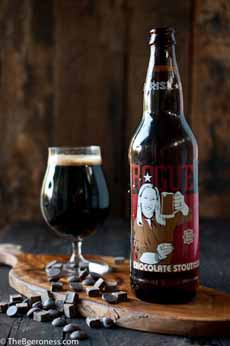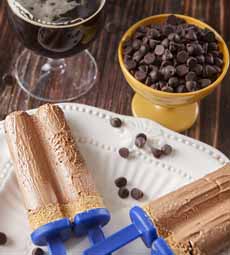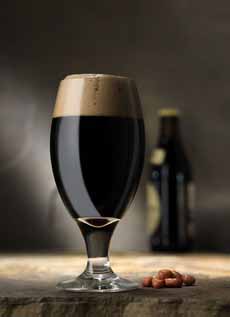RECIPES: Frozen Chocolate Cheesecake & Stout Pops, Chocolate Stout Float & The History Of Stout
|
Here are two fun, warm-day dessert recipes for the beer crowd, using stout. The history of stout is below, but let’s hop right to the recipes. Any stout pairs deliciously with anything chocolate. And chocolate stout (photo #1) pairs even better. RECIPE #1: FROZEN CHOCOLATE CHEESECAKE STOUT POPS We are the Will Rogers of cheesecake: We never met a cheesecake we didn’t like. We’ve never met an ice cream we didn’t like, as well. And we like alcohol (liqueur) in both our cheesecake and our ice cream. So when we chanced upon this recipe from Nugget Markets—a frozen chocolate cheesecake fudge pop with stout, photo #3—we knew we had to make them. There’s even a graham cracker “crust.” Prep time is 15 minutes plus overnight freezing. Ingredients For 5 Pops 1. MIX the sugar, softened cream cheese, and sour cream in a blender on low speed, until completely combined. Stir in the milk and stout. 2. MELT the dark chocolate chips over a double boiler on the stove top (or in the microwave at 30-second intervals) until completely melted. Pour the melted chocolate into blender mixture and mix until well combined. 3. SLOWLY POUR the mixture into the pop molds, tapping molds as you fill to remove any air bubbles. Leave a 1/2-inch empty space on the top for the “crust.” 4. SMASH the graham crackers until completely crumbled (we put them in a plastic bag and use a rolling pin). ADD the melted butter and stir until combined. Add on top of the chocolate mixture, spreading evenly. Insert the ice pop sticks and freeze overnight. We published recipes using chocolate stout a few years back: a chocolate stout float a few years back; along with chocolate stout ice cream. When we saw a recipe with coffee stout from the Wisconsin Milk Marketing Board (photo #3), we knew it was time to repeat the idea. In this recipe, the chocolate float is made with chocolate ice cream and coffee stout, but go for chocolate stout if you prefer. Or flip it: Have an all-coffee float with coffee stout and coffee ice cream. Here’s a chocolate stout cake recipe to go with it. Ingredients Per Drink |
 [1] Rogue Chocolate Stout is delicious in either of these recipes, plus this chocolate stout cream pie recipe from The Beeroness.  [2] Have your cheesecake pops with a glass of stout on the side (photo and recipe from Nugget Markets).
|
|
|
1. PLACE two scoops of ice cream in a pint glass or other large glass. 2. SLOWLY POUR the stout on top of ice cream to fill the glass. Serve with a straw |
||
|
|
THE HISTORY OF STOUT While man has been brewing beer since an client times, styles evolved over the millennia as different malts, yeasts, and hops became available. Stout is a relatively recent recipe. The first known use of the word “stout” for beer is in 1677. At that time, stout was a word for strong, and the document implied a strong beer, not a dark beer. Let’s skip ahead 50 years to porter, the basis of modern stout. Porter, which originated in London in the early 1720s. It was so-named because this strong beer—which was cheaper than other beers and increased in alcohol content with age—became popular with porters, among other Londoners. Within a few decades, porter breweries in London had multiplied many-fold. Large amounts were exported to Ireland, where by 1780 or so, ale brewer Arthur Guinness decided to brew his own porter (and ultimately created what would one day become the world’s most famous stout). The 19th century brought the development of black malt, the darkest of the common roasted malts. It gives beer a dark color and stronger flavor—a brew with a very different character than roasted barley-based beers. It became the standard malt for porter[source]. At that point, “stout” still meant only “strong,” and the term could be related to any strong beer (stout pale ale, for example). But because of the huge popularity of porters, brewers made them in a variety of strengths. The beers with higher gravities were called stout porters. Stout became the generic term for the strongest or stoutest porters. There is still debate on whether stouts should be designated a separate style from porter (as they are now), or simply be designated as stout [strong] porter. |
|
|
Like porter, stout is a dark beer made from roasted malt or roasted barley, hops, water and yeast. Stouts were traditionally the generic term for the strongest or stoutest porters, typically 7% or 8% ABV.
|
||


